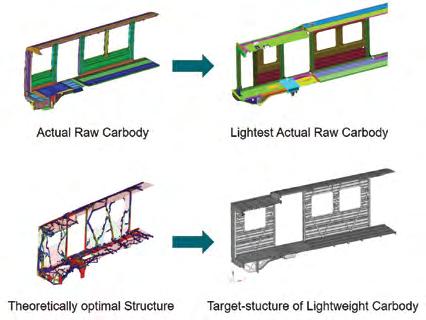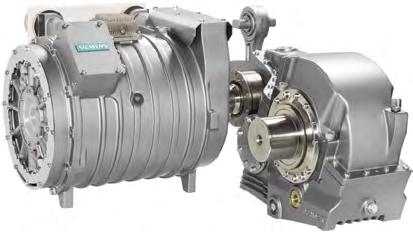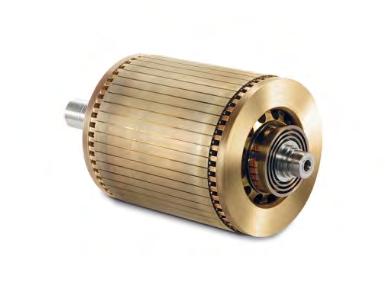
8 minute read
Saving energy in rolling stock A leading train manufacturer discusses the work being done to achieve this objective
SAVING ENERGY IN ROLLING STOCK
by Dr Florian Magerl, Head of Technical Bid Management, Siemens Mobility GmbH; Klaus Ulreich, Technical Bid Manager, Head of Tenders, Siemens Mobility GmbH; and Dr Thomas Moshammer, Head of Structure, Simulation, Validation, Siemens Mobility GmbH
Dr Florian Magerl Mr Klaus Ulreich
Dr Thomas Moshammer
A leading train manufacturer discusses the work being done to achieve this objective.
INTRODUCTION
Siemens Mobility’s key criteria in designing rolling stock are safety, the passenger experience, and lifecycle costs. In modern MRT systems, a train’s lifecycle costs are mainly driven by the costs of maintenance and energy. Throughout the designed service life of an MRT train, the train investment costs, maintenance costs, and energy costs contribute in approximately equal parts to the overall cost.
Costs over about 30 years of a train’s service life.

Leveraging the benefits of digitalisation, Siemens Mobility is at the forefront of applying innovative tools for maintenance. Railigent, the mobility application suite from Siemens Mobility Services, which runs on Mindsphere, enables rail operators to understand their rail data, generate valuable information, and get more out of their systems. Using this platform, operators can reduce lifecycle costs by extending service and maintenance intervals, and make rail transport more competitive. Using predictive maintenance helps to detect incipient failures and decreases unplanned downtime by 30% to 50%. These applications help to make 100% availability a realisitic goal.
REDUCING ENERGY COSTS
When it comes to the operator’s energy costs - the other key component in lifecycle-costs - Siemens Mobility focuses on three main factors in its rolling stock design: • Reducing vehicle weight • Designing energy-efficient traction components • Improving the energy balance by enabling full recuperation Saving weight helps the operator save money. Depending on the energy costs, the monetary savings in energy costs can be SGD 50 to SGD 100 for each kilogram of mass over the car’s lifecycle. The Siemens philosophy is to design a lightweight car, increase energy-efficiency and guarantee safe construction. To achieve these goals, the design and function of every component is optimised.
Weight optimised car-bodies
Optimising lifecycle costs is also the design principle for Siemens’ new aluminum welded car-body concept that reduces car weight by up to 25%. The fully welded aluminum structure was optimised using FEM studies conducted by Siemens engineers. Forged parts are used, instead of welded components, with integrated functionalities, which was one of the main factors in reducing vehicle weight. It allows coupler compression loads up to 1,000 kN, which exceeds the EN12663 standard’s requirements. The car body fulfills the crashworthiness requirements of EN15227.

Instead of designing CFK (carbon fibre-reinforced plastic) car-bodies, Siemens decided to use aluminum and steel, which are well-proven and well-studied materials, as the base materials for the newest trains, and accordingly optimised their application. Both materials provide the best properties for ensuring safety and high quality, that are required for products in the public transportation sector. Trains made of CFK material are lighter in weight (the bodies are 10% to 15% lighter than a lightweight car body), but CFK in car-bodies is not as well-proven as aluminum or steel, and its durability over 30 to 35 years has not yet been verified. If a CFK vehicle has an accident, the damage is worse compared with an aluminum car body, and damage to an aluminum or steel car body is also easier to repair. Aluminum and steel car bodies are heavier than CFK material car bodies, but they provide better endurance values and they guarantee greater safety.
Light-weight bogies
The standard passenger-coach bogie frame is a massive welded-steel construction. It carries the weight of the car body and passes the movement of the wheels to the train. The customer expects a bogie lifetime of at least 30 years, and it must withstand various load and environmental conditions. Maintenance should be conducted at intervals up to eight years and 3 million km. The running gear is a very important component of a rail vehicle. It is the interface between the track and the car. The bogie performs functions like track guiding, carrying the car body’s weight, integrating the motor and gearbox, and integrating braking components and primary and secondary suspension. Siemens managed to develop a new bogie frame that is 45% lighter. Instead of 1.5 t, it weighs only 900 kg. Saving that much weight on the running gear is possible thanks to innovative developments and new materials. The new bogie concept applies several lightweight design and construction innovations, including: • New bogie frame design • The use of new materials with high stability, and use of combined materials • Reduced wheelbase • Compact construction • New construction and calculation methods Siemens worked with the Erich-Schmidt Institute at the University of Leoben in Austria, to develop fracture mechanical parameters for higher strength materials (e.g. S700). In collaboration with TU-Graz, also in Austria, Siemens tested real samples for crack growth and compared them with samples of standard steel sheet S355. At the same level of utilisation, there was no increase in crack growth speed observed, compared with S355. Based on this new experience, Siemens built two prototypes of the bogie frame and integrated them in the running gears of an operating double-decker train. This train was successfully tested at intensive distances to check the stability in running behaviour and in vibration behaviour. This vehicle is now approved and is being used for public passenger transport. This innovative new bogie lays the foundation for a new generation of efficient bogies for various car families and is already in serial production for metro trains as well.

Efficient traction components and electrodynamic braking
As a train manufacturer, Siemens partners with customers to supply everything, from individual components to entire trains. The company’s innovative and reliable system solutions for traction converters, motors, and gears are perfectly synchronised and precisely customised for customers’ requirements. Drive components are supplied for other international manufacturers as well as for Siemens trains. Railway operators can rely on the many advantages of Siemens’ technology for all kinds of rolling stock. Operators benefit from the many advantages of the company’s portfolio for high-speed trains, trams, metros, regional or local trains, coaches, and locomotives. The Siemens product portfolio covers the entire control and traction system, beginning with the Siemens Train Control System (SiBAS) that provides all the signals for the combined drive and brake control unit (DBCU). These signals are tailored to customer needs, based on the track, load, acceleration, time schedule, and brake characteristics. The Siemens in-house traction converter units cover a wide range from 460 kW to 1,100 kW in two voltage classes, 750 VDC and 1,500 VDC, to power the traction motors. In conjunction with the Siemens brake system, this system allows a 100% electrodynamic braking from maximum speed down to zero, so the system can recuperate the entire braking energy back into the power network. In this case, the electropneumatic brake system is used only as an emergency brake, which helps increase the lifespan of the brake paddles and reduce the amount of brake abrasion dust in tunnel systems. For traction motors, Siemens builds a wide range of asynchronous motors and permanent-magnet motors. Copper is used in the rotor design, which results in low losses due to the metal’s superior conductivity. Lower losses translate into higher energy-efficiency and an increased power-to-weight ratio. The permanent-magnet motors are ideal for applications with very demanding efficiency requirements, because no energy is needed to set up the rotor field. Depending on customers’ requirements, Siemens engineers will choose from available products, optimise an existing motor, and they can also design a completely new motor type.
Commitment to energy-efficiency
Energy-efficiency does not just benefit operators - it also minimises impacts on the environment, making public transportation even more competitive in dense urban areas. By giving a train’s lifetime energy expenditure the same weight as investment and maintenance costs in evaluations, and even considering the environmental benefits of decreased energy consumption, operators can assess the actual lifecycle costs of new fleets. Therefore, it is extremely important to make energy consumption transparent, and this is the responsibility of authorities, train operators and train suppliers, alike. Siemens Mobility has been testing its components and trains for more than 20 years in the Test and Validation Center Wildenrath (PCW) in western Germany. This is where almost all of the trains made by Siemens are inspected under realistic conditions. From high-speed trains and locomotives to commuter trains, metros, and light-rail vehicles, just about every type of rail vehicle can be inspected and certified at the PCW. The testing includes simulation of real operating conditions and the exact measurement of energy consumption before trains start running on the operator’s infrastructure. These measurements allow Siemens, as train suppliers, to further optimise traction settings where necessary and, in some cases, revise the design of selected components before the train starts operations. Today, energy consumption can be traced throughout a train’s actual operation, and commitments to reduce energy consumption figures need to be kept, and incentivised if applicable. Penalties should be imposed if these commitments are broken. This gives the operator, and ultimately, society, the benefit of energy-efficient and environment-friendly trains that, in some cases, can even evolve throughout their service life, contributing even more to lifecycle cost reductions.











